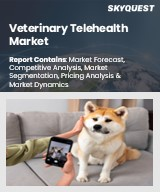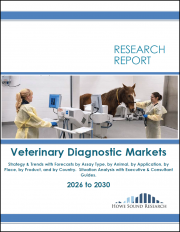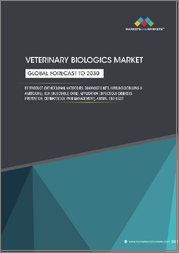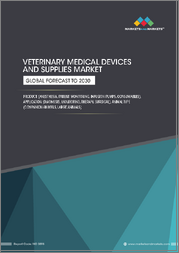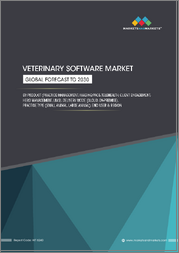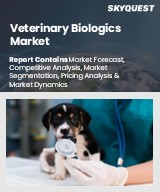
|
시장보고서
상품코드
1796151
동물용 생물제제 시장 규모, 점유율, 성장 분석 : 유형별, 유형별, 대상 질환별, 공급원별, 지역별 - 산업 예측(2025-2032년)Veterinary Biologics Market Size, Share, and Growth Analysis, By Type (Vaccines, Antibiotics), By Species, By Target Disease, By Source, and By Regions -Industry Forecast 2025-2032. |
||||||
세계의 동물용 생물제제 시장 규모는 2023년에 264억 4,000만 달러로 평가되며, 2024년 275억 8,000만 달러에서 2032년에는 386억 5,000만 달러로 성장하며, 예측 기간(2025-2032년)의 CAGR은 4.31%로 성장할 전망입니다.
동물용 생물제제 시장은 동물의 건강에 대한 관심이 높아지고 반려동물의 건강에 대한 보호자들의 인식이 높아짐에 따라 괄목할 만한 성장세를 보이고 있습니다. 반려동물 사육 증가와 가축 생산 증가는 이 분야의 확장을 더욱 촉진하고 있습니다. 인수공통전염병 증가는 예방 조치의 필요성을 강조하며 동물용 생물제제에 대한 투자를 강화하고 있습니다. 재조합 백신, DNA 백신, 단클론 항체와 같은 차세대 생물제제, 첨단 생명공학 플랫폼과 같은 기술 혁신이 이러한 상황을 바꾸고 있습니다. 또한 콜드체인 물류의 개선과 원격지에 대한 광범위한 접근은 백신에 대한 접근성과 효능을 높이는 데 매우 중요합니다. 전반적으로 정부의 강력한 노력과 공동 연구개발 노력은 축우, 가금류, 반려동물, 수산양식 등 다양한 부문에서 충분한 성장 기회를 제공합니다.
목차
서론
- 조사의 목적
- 조사 범위
- 정의
조사 방법
- 정보 조달
- 2차와 1차 데이터 방법
- 시장 규모 예측
- 시장의 전제조건과 제한
개요
- 세계 시장 전망
- 공급과 수요 동향 분석
- 부문별 기회 분석
시장 역학과 전망
- 시장 개요
- 시장 규모
- 시장 역학
- 촉진요인과 기회
- 억제요인과 과제
- Porter의 산업 분석
주요 시장 인사이트
- 주요 성공 요인
- 경쟁의 정도
- 주요 투자 기회
- 시장 에코시스템
- 시장의 매력 지수(2024년)
- PESTEL 분석
- 거시경제 지표
- 밸류체인 분석
- 가격 분석
- 기술 분석
- 사례 연구
- 고객 구매 행동 분석
동물용 생물제제 시장 규모 : 유형별 & CAGR(2025-2032)
- 시장 개요
- 백신
- 항생제
- 구충약
- 성장 촉진제
동물용 생물제제 시장 규모 : 유형별 & CAGR(2025-2032)
- 시장 개요
- 가축
- 반려동물
동물용 생물제제 시장 규모 : 대상 질환별 & CAGR(2025-2032)
- 시장 개요
- 세균 감염증
- 바이러스 감염
- 기생충 감염증
- 대사장애
동물용 생물제제 시장 규모 : 공급원별 & CAGR(2025-2032)
- 시장 개요
- 세포배양
- 불활성화된 병원체
- 재조합 기술
동물용 생물제제 시장 규모 : 지역별 & CAGR(2025-2032)
- 북미
- 미국
- 캐나다
- 유럽
- 독일
- 스페인
- 프랑스
- 영국
- 이탈리아
- 기타 유럽 지역
- 아시아태평양
- 중국
- 인도
- 일본
- 한국
- 기타 아시아태평양
- 라틴아메리카
- 브라질
- 기타 라틴아메리카 지역
- 중동 및 아프리카
- GCC 국가
- 남아프리카공화국
- 기타 중동 및 아프리카
경쟁 정보
- 상위 5사의 비교
- 주요 기업의 시장 포지셔닝(2024년)
- 주요 시장 기업이 채택한 전략
- 최근 시장 동향
- 기업의 시장 점유율 분석(2024년)
- 주요 기업의 기업 개요
- 기업의 상세
- 제품 포트폴리오 분석
- 기업의 부문별 점유율 분석
- 매출의 전년대비 비교(2022-2024년)
주요 기업 개요
- Hipra
- Zoetis
- Boehringer Ingelheim
- Tsinghua Tongda
- Bayer Animal Health
- Intervet
- Elanco Animal Health
- Ceva Animal Health
- Vetoquinol
- Beijing SVA Vaccines Serums
- Virbac
- Harbin Veterinary Research Institute
- Shenzhen Kangtai Biological Products
- Chongqing Zhifei Biological Products
- Merck Animal Health
결론과 제안
KSA 25.08.29Global Veterinary Biologics Market size was valued at USD 26.44 billion in 2023 and is poised to grow from USD 27.58 billion in 2024 to USD 38.65 billion by 2032, growing at a CAGR of 4.31% in the forecast period (2025-2032).
The veterinary biologics market is experiencing notable growth driven by heightened emphasis on animal health and the rising awareness among pet owners regarding their pets' wellbeing. Increasing pet ownership and livestock production further fuel this sector's expansion. The rise in zoonotic diseases underscores the need for preventive measures, enhancing investment in veterinary biologics. Innovations such as recombinant vaccines, next-generation biologics like DNA vaccines and monoclonal antibodies, and advanced biotechnological platforms are transforming the landscape. Additionally, improved cold chain logistics and extensive outreach to remote areas are crucial for enhancing vaccine access and efficacy. Overall, robust government initiatives and collaborative R&D efforts present ample opportunities for growth across various segments, including cattle, poultry, companion animals, and aquaculture.
Top-down and bottom-up approaches were used to estimate and validate the size of the Global Veterinary Biologics market and to estimate the size of various other dependent submarkets. The research methodology used to estimate the market size includes the following details: The key players in the market were identified through secondary research, and their market shares in the respective regions were determined through primary and secondary research. This entire procedure includes the study of the annual and financial reports of the top market players and extensive interviews for key insights from industry leaders such as CEOs, VPs, directors, and marketing executives. All percentage shares split, and breakdowns were determined using secondary sources and verified through Primary sources. All possible parameters that affect the markets covered in this research study have been accounted for, viewed in extensive detail, verified through primary research, and analyzed to get the final quantitative and qualitative data.
Global Veterinary Biologics Market Segments Analysis
The veterinary biologics market is segmented into type, species, target disease, source, and region. By type, the market is classified into vaccines, antibiotics, Antiparasitic, and growth promoters. Depending on the species, it is bifurcated into livestock and companion animals. According to target disease, the market is divided into bacterial infections, viral infections, parasitic infections, and metabolic disorders. As per the supported source, it is categorised into cell culture, inactivated pathogens, and recombinant technologies. Regionally, it is analyzed across North America, Europe, Asia-Pacific, Latin America, and the Middle East & Africa.
Driver of the Global Veterinary Biologics Market
One of the key market drivers for the Global Veterinary Biologics Market is the increasing prevalence of zoonotic diseases that can be transmitted from animals to humans. As urbanization and human-animal interactions rise, the risk of such diseases escalates, prompting governments and healthcare organizations to prioritize animal health management. This, in turn, drives demand for vaccines and biologics that ensure the health and productivity of livestock and companion animals. Additionally, growing awareness among pet owners regarding animal health and the importance of preventive care further propels the market, as consumers seek effective solutions to protect their animals from infectious diseases.
Restraints in the Global Veterinary Biologics Market
One key market restraint impacting the global veterinary biologics market is the stringent regulatory environment governing the approval and commercialization of veterinary products. The complex and lengthy process for obtaining necessary certifications and licenses can delay market entry for new vaccines and therapeutics, hampering innovation and accessibility. Additionally, varying regulatory standards across countries may complicate international trade and distribution, limiting market potential for manufacturers. These challenges can create barriers for smaller companies and new entrants, fostering an environment where larger, established players dominate, ultimately stifling competition and reducing the overall growth potential of the veterinary biologics sector.
Market Trends of the Global Veterinary Biologics Market
The Global Veterinary Biologics market is experiencing a marked shift towards recombinant DNA and vector-based vaccines, reflecting an industry-wide trend favoring innovative and efficient solutions. This transition from traditional live and inactivated vaccines is driven by the advantages these novel technologies present, such as enhanced safety profiles, strain specificity, and rapid production capabilities, essential for addressing the challenges posed by emerging and mutating diseases. Investments from both established companies and startups in recombinant platforms are increasing, driven by advancements in cell culture and synthetic biology, ultimately aiming to meet the diverse health needs of both companion and large livestock animals.
Table of Contents
Introduction
- Objectives of the Study
- Scope of the Report
- Definitions
Research Methodology
- Information Procurement
- Secondary & Primary Data Methods
- Market Size Estimation
- Market Assumptions & Limitations
Executive Summary
- Global Market Outlook
- Supply & Demand Trend Analysis
- Segmental Opportunity Analysis
Market Dynamics & Outlook
- Market Overview
- Market Size
- Market Dynamics
- Drivers & Opportunities
- Restraints & Challenges
- Porters Analysis
- Competitive rivalry
- Threat of substitute
- Bargaining power of buyers
- Threat of new entrants
- Bargaining power of suppliers
Key Market Insights
- Key Success Factors
- Degree of Competition
- Top Investment Pockets
- Market Ecosystem
- Market Attractiveness Index, 2024
- PESTEL Analysis
- Macro-Economic Indicators
- Value Chain Analysis
- Pricing Analysis
- Technology Analysis
- Case Studies
- Customer Buying Behavior Analysis
Global Veterinary Biologics Market Size by Type & CAGR (2025-2032)
- Market Overview
- Vaccines
- Antibiotics
- Antiparasitic
- Growth Promoters
Global Veterinary Biologics Market Size by Species & CAGR (2025-2032)
- Market Overview
- Livestock
- Companion Animals
Global Veterinary Biologics Market Size by Target Disease & CAGR (2025-2032)
- Market Overview
- Bacterial Infections
- Viral Infections
- Parasitic Infections
- Metabolic Disorders
Global Veterinary Biologics Market Size by Source & CAGR (2025-2032)
- Market Overview
- Cell Culture
- Inactivated Pathogens
- Recombinant Technologies
Global Veterinary Biologics Market Size & CAGR (2025-2032)
- North America (Type, Species, Target Disease, Source)
- US
- Canada
- Europe (Type, Species, Target Disease, Source)
- Germany
- Spain
- France
- UK
- Italy
- Rest of Europe
- Asia Pacific (Type, Species, Target Disease, Source)
- China
- India
- Japan
- South Korea
- Rest of Asia-Pacific
- Latin America (Type, Species, Target Disease, Source)
- Brazil
- Rest of Latin America
- Middle East & Africa (Type, Species, Target Disease, Source)
- GCC Countries
- South Africa
- Rest of Middle East & Africa
Competitive Intelligence
- Top 5 Player Comparison
- Market Positioning of Key Players, 2024
- Strategies Adopted by Key Market Players
- Recent Developments in the Market
- Company Market Share Analysis, 2024
- Company Profiles of All Key Players
- Company Details
- Product Portfolio Analysis
- Company's Segmental Share Analysis
- Revenue Y-O-Y Comparison (2022-2024)
Key Company Profiles
- Hipra
- Company Overview
- Business Segment Overview
- Financial Updates
- Key Developments
- Zoetis
- Company Overview
- Business Segment Overview
- Financial Updates
- Key Developments
- Boehringer Ingelheim
- Company Overview
- Business Segment Overview
- Financial Updates
- Key Developments
- Tsinghua Tongda
- Company Overview
- Business Segment Overview
- Financial Updates
- Key Developments
- Bayer Animal Health
- Company Overview
- Business Segment Overview
- Financial Updates
- Key Developments
- Intervet
- Company Overview
- Business Segment Overview
- Financial Updates
- Key Developments
- Elanco Animal Health
- Company Overview
- Business Segment Overview
- Financial Updates
- Key Developments
- Ceva Animal Health
- Company Overview
- Business Segment Overview
- Financial Updates
- Key Developments
- Vetoquinol
- Company Overview
- Business Segment Overview
- Financial Updates
- Key Developments
- Beijing SVA Vaccines Serums
- Company Overview
- Business Segment Overview
- Financial Updates
- Key Developments
- Virbac
- Company Overview
- Business Segment Overview
- Financial Updates
- Key Developments
- Harbin Veterinary Research Institute
- Company Overview
- Business Segment Overview
- Financial Updates
- Key Developments
- Shenzhen Kangtai Biological Products
- Company Overview
- Business Segment Overview
- Financial Updates
- Key Developments
- Chongqing Zhifei Biological Products
- Company Overview
- Business Segment Overview
- Financial Updates
- Key Developments
- Merck Animal Health
- Company Overview
- Business Segment Overview
- Financial Updates
- Key Developments







